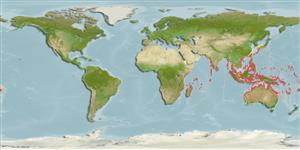Gastropoda |
Trochida |
Turbinidae
Environment: milieu / climate zone / depth range / distribution range
Ecology
Benthic; depth range 0 - 20 m (Ref. 349). Tropical
Indo-West Pacific.
Length at first maturity / Size / Weight / Age
Maturity: Lm ? range ? - ? cm Max length : 8.0 cm SHL male/unsexed; (Ref. 349); common length : 6.0 cm SHL male/unsexed; (Ref. 349)
Shell turbinate, moderately large, solid and heavy. Spire well-developed, pointed, with a strong convex whorls, angular shoulders. Body whorl biangulate, with stronger spiral cords. Aperture roughly rounded-ovate. Umbilicus closed or reduced to a slight chink. Colouration: Outside of operculum approximately smooth, with oblique marginal grooves, and brown or dark green; aperture mostly orange-yellow (Ref. 128042).
Frequently collected for food locally by coastal people, where abundant. Shell used in shellcraft (Ref. 349). Found in intertidal to 30 m, on rocks (Ref. 75835). Also found in coral reefs (Ref. 128042).
Life cycle and mating behavior
Maturity | Reproduction | Spawning | Eggs | Fecundity | Larvae
Members of the order Patellogastropoda are mostly gonochoric and broadcast spawners. Life cycle: Embryos develop into planktonic trocophore larvae and later into juvenile veligers before becoming fully grown adults.
Poutiers, J.M. 1998. (Ref. 349)
IUCN Red List Status (Ref. 130435)
CITES status (Ref. 108899)
Not Evaluated
Not Evaluated
Threat to humans
Harmless
Human uses
| FishSource |
Tools
Internet sources
Estimates based on models
Preferred temperature
(Ref.
115969): 24.9 - 29.3, mean 28.5 (based on 3075 cells).
Vulnerability
Low vulnerability (10 of 100).
